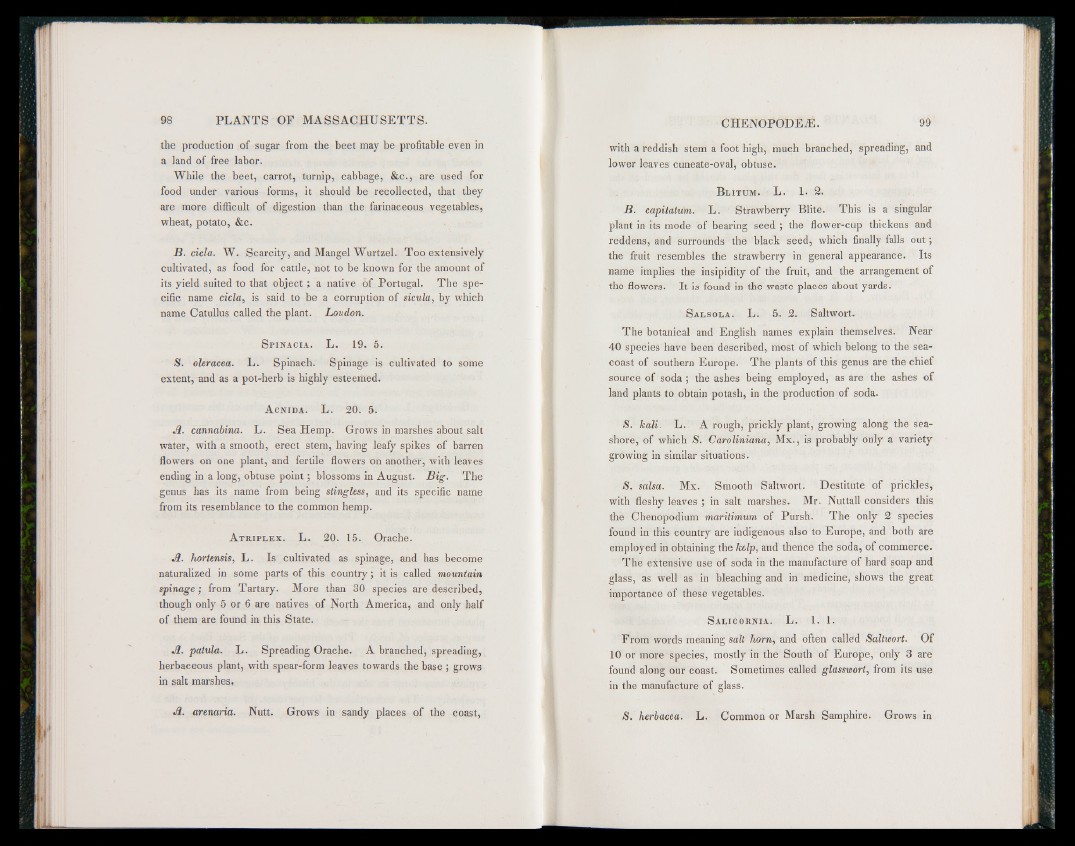
the production of sugar from the beet may he profitable even in
a land of free labor.
While the beet, carrot, turnip, cabbage, &c., are used for
food under various forms, it should be recollected, that they
are more difficult of digestion than the farinaceous vegetables,
wheat, potato, &c.
B. cicla. W. Scarcity, and Mangel Wurtzel. Too extensively
cultivated, as food for cattle, not to be known for the amount of
its yield suited to that object; a native of Portugal. The specific
name cicla, is said to be a corruption of sicula, by which
name Catullus called the plant. Loudon.
S pinacia. L. 19. 5.
/S. oleracea. L. Spinach. Spinage is cultivated to some
extent, and as a pot-herb is highly esteemed.
A cnida. L. 20. 5.
A. cannabina. L. Sea Hemp. Grows in marshes about salt
water, with a smooth, erect stem, having leafy spikes of barren
flowers on one plant, and fertile flowers on another, with leaves
ending in a long, obtuse point; blossoms in August. Big. The
genus has its name from being stingless, and its specific name
from its resemblance to the common hemp.
A t r ip l e x . L. 20. 15. Orache.
A. hortensis, L. Is cultivated as spinage, and has become
naturalized in some parts of this country; it is called mountain
spinage; from Tartary. More than 30 species are described,
though only 5 or 6 are natives of North America, and only half
of them are found in this State.
A. patula. L. Spreading Orache. A branched, spreading,
herbaceous plant, with spear-form leaves towards the base ; grows
in salt marshes,
A. arenaria. Nutt. Grows in sandy places of the coast,
with a reddish stem a foot high, much branched, spreading, and
lower leaves cuneate-oval, obtuse.
Blitum. L. 1. 2.
B . capitatum. L. Strawberry Blite. This is a singular
plant in its mode of bearing seed ; the flower-cup thickens and
reddens, and surrounds the black seed, which finally falls o u t;
the fruit resembles the strawberry in general appearance. Its
name implies the insipidity of the fruit, and the arrangement of
the flowers. It is found in the waste places about yards.
Salsola. L. 5. 2. Saltwort.
The botanical and English names explain themselves. Near
40 species have been described, most of which belong to the sea-
coast of southern Europe. The plants of this genus are the chief
source of soda ; the ashes being employed, as are the ashes of
land plants to obtain potash, in the production of soda.
S. kali. L. A rough, prickly plant, growing along the seashore,
of which S. Caroliniana, Mx., is probably only a variety
growing in similar situations.
<S. salsa. Mx. Smooth Saltwort. Destitute of prickles,
with fleshy leaves ; in salt marshes. Mr. Nuttall considers this
the Chenopodium maritimum of Pursh. The only 2 species
found in this country are indigenous also to Europe, and both are
employed in obtaining the kelp, and thence the soda, of commerce.
The extensive use of soda in the manufacture of hard soap and
glass, as well as in bleaching and in medicine, shows the great
importance of these vegetables.
Salicornia. L. 1. 1.
From words meaning salt horn, and often called Saltwort. Of
10 or more species, mostly in the South of Europe, only 3 are
found along our coast. Sometimes called glasswort, from its use
in the manufacture of glass.
S. herbacea. L. Common or Marsh Samphire. Grows in